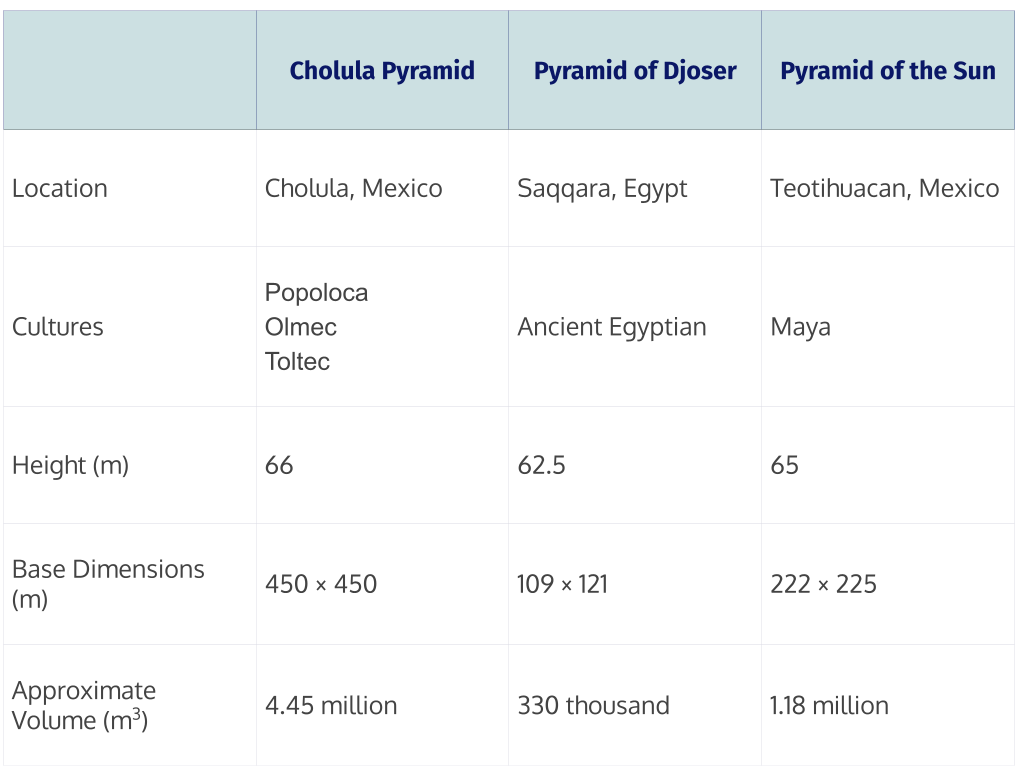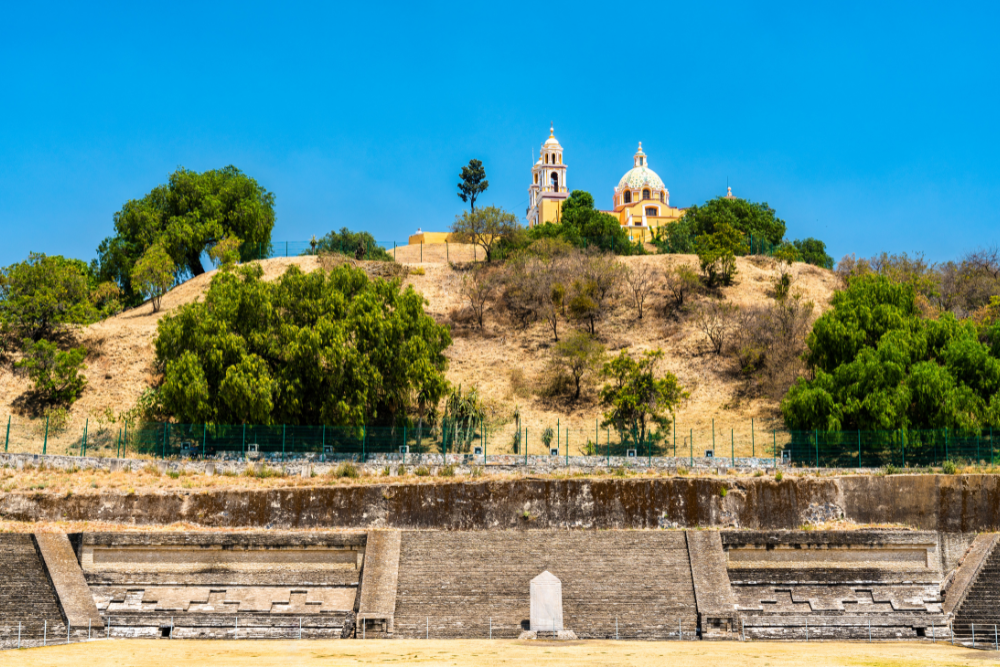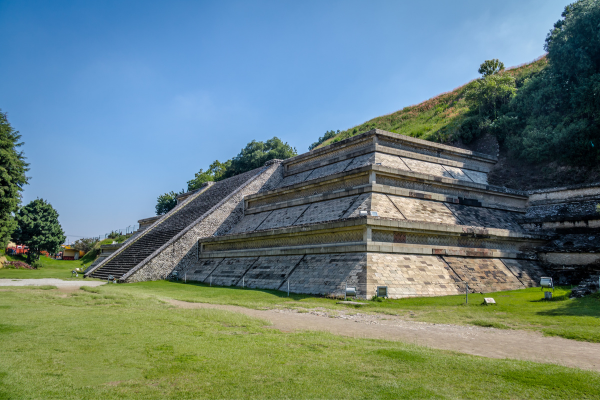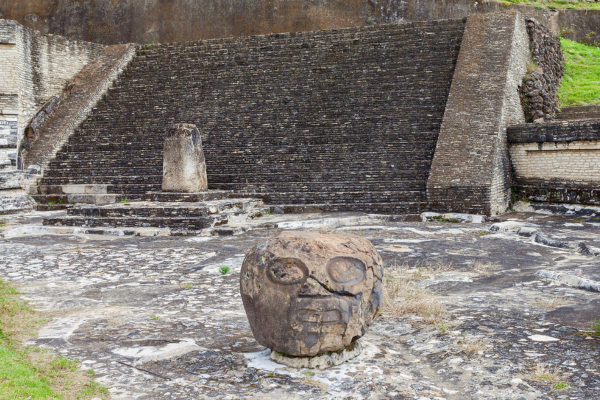MEXICO
The Mountain Made by Hand
By Davis Church, João Gasparian, Jagger Stachtiaris, Roshan Gopal, Varun Gupta, Shaye Kirman, Thierry Lawrence, Evan Song, Derek Tang, and Chance Nalley
New York City, NY, United States
A fascinating archaeological site, a beautiful tourist destination, and an architectural marvel, the Great Pyramid of Cholula is a place where history comes to life. Called Tlachihualtepetl, “handmade mountain,” in the native Nahuatl language, the pyramid was built over several centuries by multiple civilizations in what is now the city of Cholula, Mexico.
Archaeologists believe three pre-Columbian societies constructed this temple as a focal point for religious rituals, ceremonies, and offerings to the gods. Believed to have been dedicated to the deity Quetzalcoatl, its use aligns with many religious practices typical of cultures of the region.
More than just an impressive building, the pyramid was the heart of a thriving population center. Some records suggest that, at its peak, Cholula housed 100,000 residents, making it one of the largest Mesoamerican cities of its era, comparable to ancient Athens or Jerusalem. Today, tucked into la zona arqueologica de Cholula (“architectural zone of Cholula”), the temple stands watch over the longest continuously inhabited city in North America.
A Colossal Monument
Though it may look like a natural hill, the Great Pyramid of Cholula is the most volumetric human-made pyramid in the world. The temple rises only to a height of approximately 66 meters (m) or 217 feet (ft.), but its base measures an impressive 450 by 450 m (1,476 by 1,476 ft.). This massive base area sets it apart from other pyramids and accounts for its estimated volume of 4.45 million m³ (around 157 million cu. ft.). Comparatively, the Great Pyramid of Giza has a volume of just 2.6 million m³ (around 92 million cu. ft.). The following table shows how the pyramid at Cholula stacks up to other impressive structures.
 Ancient Origins
Ancient Origins
Historians estimate that the construction of the Great Pyramid of Cholula began more than 2,000 years ago, around 300 BCE. Although it’s not clear what inspired the original builders, its base design is similar to the architecture of neighboring cultures. Over the following centuries, the Olmecs and Toltecs contributed additional layers that rose from the foundation, eventually forming the final structure around 1200 CE.
The pyramid’s spiritual significance is deeply rooted in the beliefs of Mesoamerican civilizations. The monumental edifice acted as a gateway to the heavens, where societies honored gods and communed with ancestors. Over time, however, as Cholula’s political authority waned, the temple became overgrown with vegetation. Its original purpose disappeared underneath soil and debris.
With the invasion of Spanish conquistadors in the 16th century, the pyramid’s destiny shifted. They constructed the Iglesia de Nuestra Señora de los Remedios (“Church of Our Lady of the Remedies”) on top of what they mistakenly assumed was a hill. This act obscured an important part of Cholula’s Indigenous cultural heritage.

Legacy
The Great Pyramid of Cholula is now a popular site for tourists, drawing over 200,000 visitors annually. Many are pilgrims visiting the Catholic church at its summit, while others are simply there to gaze in awe upon a vast ancient ruin.
Unfortunately, few visitors to the site have a full understanding of its spiritual and historical significance. Recent initiatives to acknowledge the temple’s Indigenous origins signal an increasing acknowledgment of its heritage. Too often Indigenous history is overlooked, but this remarkable structure serves as a reminder of the contributions and achievements of Mexico’s first peoples.
Have a suggestion for this story? We’d love for you to submit it!


Blank
Blank
Math Resources
Sample Problems for Elementary School:
- Pretend the length of one side of your house is 100 m. How much longer is one side of the Great Pyramid of Cholula than that side of your house? Would the pyramid’s side be a realistic size for a house? (Grade 2)
- How many more cubic meters is the volume of the Great Pyramid of Cholula than the Great Pyramid of Giza? (Grades 2–3)
- What is the perimeter of the base of the Great Pyramid of Cholula? How would that perimeter change if it were 1 m wider in each direction? 2 m wider? 5 m wider? 100 m wider? (Grades 3–4)
Sample Problems for Middle School:
- Approximately how much time did the Great Pyramid of Cholula take to complete? How many generations of people were born and died while the pyramid was being built? Is there any building in the modern world that has taken a similar amount of time to build? (Grade 5)
- What is the ratio between the volume of the Great Pyramid of Cholula and the Great Pyramid of Djoser? (Grade 6)
Sample Problems for High School:
- The Pyramid of the Khafre, another historically notable temple constructed in Giza, Egypt, has a base measuring 215.5 by 215.5 m and a volume of 2.21 million m³. Roughly how much taller is the Pyramid of Cholula than this pyramid? (Hint: Use the general volume formula for a pyramid.) (Grade 9)
- How many square meters of tarp would it take to cover the entire pyramid? (Grade 10)
- Grade 11 Challenge: Consider a pyramid with similar dimensions to the Pyramid of Cholula. Estimate at what angle of elevation a sun facing one of its sides would be to cast a shadow equal to the pyramid’s base area.
Social Justice Questions
- The Great Pyramid of Cholula was an important Indigenous cultural site that was covered by Spanish colonists. Historically, many colonizers have suppressed Indigenous history to establish their own power and influence. How can we better our practices as students to ensure that Indigenous history is remembered and respected? Are there any examples in current events of similar cultural repression? How can we combat it?
- The Great Pyramid of Cholula’s construction is a testament to what can be achieved when cultures and generations work together. What do intercultural and intergenerational collaboration look like in your life? What legacy do you hope to leave behind for future generations to build on?
- Two other pyramids are listed in the table. Research the societies that built these pyramids and compare their construction histories to that of the Great Pyramid of Cholula.
Explore Further
- Webpage for kids about the pyramid
- More information about the pyramid’s construction
- Historical facts about the pyramid and the city of Cholula
- Travel video with scenes of the pyramid, church, and surroundings starting at 6:00
Share Your Story
Write your own Global Math Story and send it to us!
Sorry, the comment form is closed at this time.